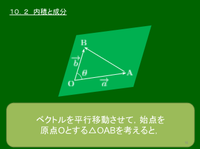このページにある内容は,こちらのスライド(会員向け)でわかり易く説明しています.
高校数学[総目次]
数学B 第1章 ベクトル
| スライド | ノート | |
| 1. ベクトルと有向線分 | [無料] | |
| 2. ベクトルの演算 | [無料] | |
| 3. ベクトルの成分 | [無料] | |
| 4. ベクトルの内積 | [会員] | |
| 5. 位置ベクトル | [会員] | |
| 6. ベクトル方程式 | [会員] | |
| 7. 平面ベクトルの応用 | [会員] | |
| 8. 空間ベクトル | [会員] | |
| 9. 空間ベクトルの成分 | [会員] | |
| 10. 空間ベクトルの内積 | [会員] | |
| 11. 空間の位置ベクトル | [会員] | |
| 12. 空間ベクトルの応用 | [会員] | |
| 13. 空間のベクトル方程式 | [会員] |
10. 空間ベクトルの内積
10.1 空間ベクトルの内積
空間内の$\overrightarrow{0}$でない2つのベクトル$\overrightarrow{\mathstrut a},\ \overrightarrow{b}$のなす角を$\theta$とすると,\[\overrightarrow{\mathstrut a}\cdot\overrightarrow{b}=|\overrightarrow{\mathstrut a}||\overrightarrow{b}|\cos\theta\ \ (0^\circ\leqq\theta\leqq180^\circ)\]
補足
$\overrightarrow{\mathstrut a}=\overrightarrow{0}$,または$ \overrightarrow{b}=\overrightarrow{0}$のとき,$\overrightarrow{\mathstrut a}\cdot\overrightarrow{b}=0$と定義する.
10.2 内積と成分
$\overrightarrow{\mathstrut a}=(a_1,\ a_2,\ a_3),\ \overrightarrow{\mathstrut b}=(b_1,\ b_2,\ b_3)$ のとき,
$[1]\ \ \overrightarrow{\mathstrut a}\cdot\overrightarrow{\mathstrut b}=a_1b_1+a_2b_2+a_3b_3$
$[2]\ \ \overrightarrow{\mathstrut a}\!\neq\!\overrightarrow{0}$,$\overrightarrow{\mathstrut b}\!\neq\!\overrightarrow{\mathstrut 0}$ のとき,$\overrightarrow{\mathstrut a}$ と $\overrightarrow{\mathstrut b}$ のなす角を $\theta$ とすると, \[\begin{align*} \cos\theta&=\frac{\overrightarrow{\mathstrut a}\cdot\overrightarrow{\mathstrut b}}{|\overrightarrow{\mathstrut a}||\overrightarrow{\mathstrut b}|}\\ &=\frac{a_1b_1+a_2b_2+a_3b_3}{\sqrt{{a_1}^2+{a_2}^2+{a_3}^2}\sqrt{{b_1}^2+{b_2}^2+{b_3}^2}} \end{align*}\]
[1]の証明

余弦定理により,
AB$^2=$ OA$^2+$ OB$^2-2$ OA$\cdot$OB $\cos\theta$
\[\therefore |\overrightarrow{\mathstrut b}-\overrightarrow{\mathstrut a}|^2=|\overrightarrow{\mathstrut a}|^2+|\overrightarrow{\mathstrut b}|^2-2\overrightarrow{\mathstrut a}\cdot\overrightarrow{\mathstrut b}\]
$\therefore \overrightarrow{\mathstrut a}\cdot\overrightarrow{\mathstrut b}=\dfrac{|\overrightarrow{\mathstrut a}|^2+|\overrightarrow{\mathstrut b}|^2-|\overrightarrow{\mathstrut b}-\overrightarrow{\mathstrut a}|^2}2\ \ \cdots$ ①
(①の右辺の分子)$=({a_1}^2\!+\!{a_2}^2\!+\!{a_3}^2)\!+\!({b_1}^2\!+\!{b_2}^2\!+\!{b_3}^2)$
$-\{(b_1\!-\!a_1)^2\!+\!(b_2\!-\!a_2)^2\!+\!(b_3\!-\!a_3)^2\}$
$=2(a_1b_1+a_2b_2+a_3b_3)$
よって①より,
\[\overrightarrow{\mathstrut a}\cdot\overrightarrow{\mathstrut b}=a_1b_1+a_2b_2+a_3b_3\]
■
例題 $\overrightarrow{a}=(-1,\ 2,\ -2),\ \overrightarrow{b}=(2,\ -2,\ 3)$の両方に垂直で,大きさが3であるベクトル$\overrightarrow{p}$を求めよ.
$\overrightarrow{\mathstrut a}$,$\overrightarrow{\mathstrut b}$ の双方に垂直なベクトルの1つを $\overrightarrow{\mathstrut q}=(x,y,z)$ とすると,
$\overrightarrow{\mathstrut q}\perp\overrightarrow{\mathstrut a}$ より $\overrightarrow{\mathstrut q}\cdot\overrightarrow{\mathstrut a}=0$
$\therefore -x+2y-2z=0\ \ \cdots$ ①
$\overrightarrow{\mathstrut q}\perp\overrightarrow{\mathstrut b}$ より $\overrightarrow{\mathstrut q}\cdot\overrightarrow{\mathstrut b}=0$
$\therefore 2x-2y+3z=0\ \ \cdots$ ②
①$+$② より,$x+z=0$ $\therefore x=-z\ \ \cdots$ ③
①$\times2+$② より,$2y-z=0$ $\therefore y=\dfrac z2\ \ \cdots$ ④
③,④ で $z=2$ とおくと,$\overrightarrow{\mathstrut q}=(-2,1,2)$
よって, \[\begin{align*} \overrightarrow{\mathstrut p}&=\pm3\cdot\frac{\overrightarrow{\mathstrut q}}{|\overrightarrow{\mathstrut q}|}=\pm3\cdot\dfrac{(-2,1,2)}3\\[5pt] &=\underline{\boldsymbol{\pm(-2,1,2)}} \end{align*}\]
補足
$\overrightarrow{\mathstrut a}$ と $\overrightarrow{\mathstrut b}$ の双方に垂直なベクトルの1つを $\overrightarrow{\mathstrut q}$ とすると,次のような計算によって $\overrightarrow{\mathstrut q}$ を求めることができる.(詳しくはスライド(会員向け)参照.)

\[\begin{align*} \overrightarrow{\mathstrut q}&=\Bigl(2\!\cdot\!3\!-\!(-2)\!\cdot\!(-2),\ (-2)\!\cdot\!2\!-\!(-1)\!\cdot\!3,\ -1\!\cdot\!(-2)\!-\!2\!\cdot\!2\Bigr)\\[5pt] &=(2,\ -1,\ -2) \end{align*}\]
実際,
\[\begin{align*} \overrightarrow{\mathstrut a}\cdot\overrightarrow{\mathstrut q}&=(-1,2,-2)\cdot(-2,1,2)=2+2-4=0\\[5pt] \overrightarrow{\mathstrut b}\cdot\overrightarrow{\mathstrut q}&=(2,-2,3)\cdot(-2,1,2)=-4-2+6=0\\[5pt] \end{align*}\]
となるから $\overrightarrow{\mathstrut a}\perp\overrightarrow{\mathstrut q}$ かつ $\overrightarrow{\mathstrut b}\perp\overrightarrow{\mathstrut q}$ である.
$\overrightarrow{\mathstrut q}$ を $\overrightarrow{\mathstrut a}$ と $\overrightarrow{\mathstrut b}$ の外積またはベクトル積という.ベクトル積は,2つのベクトルから1つのベクトルが返される.一方,内積は2つのベクトルから1つの実数が返される.従って内積のことをスカラー積ともいう.
10.3 内積の性質
\begin{align*} &[1]\ \ \overrightarrow{\mathstrut{a}}\cdot\overrightarrow{b}=\overrightarrow{b}\cdot\overrightarrow{\mathstrut{a}}\ \ (\mbox{交換法則})\\[5pt] &[2]\ \ \overrightarrow{a}\cdot\overrightarrow{a}=\left|\overrightarrow{a}\right|^2\\[5pt] &[3]\ \ \overrightarrow{\mathstrut{a}}\cdot(\overrightarrow{b}+\overrightarrow{\mathstrut{c}})=\overrightarrow{\mathstrut{a}}\cdot\overrightarrow{b}+\overrightarrow{\mathstrut{a}}\cdot\overrightarrow{\mathstrut{c}}\ \ (\mbox{分配法則})\\[5pt] &[4]\ \ (\overrightarrow{\mathstrut{a}}+\overrightarrow{b})\cdot\overrightarrow{\mathstrut{c}}=\overrightarrow{\mathstrut{a}}\cdot\overrightarrow{\mathstrut{c}}+\overrightarrow{b}\cdot\overrightarrow{\mathstrut{c}}\ \ (\mbox{分配法則})\\[5pt] &[5]\ \ (k\overrightarrow{\mathstrut{a}})\cdot\overrightarrow{b}=\overrightarrow{a}\cdot(k\overrightarrow{b})=k(\overrightarrow{\mathstrut{a}}\cdot\overrightarrow{b})\ \ (k\mbox{ は実数}) \end{align*}
補足
平面ベクトルの内積の性質と完全に同一である.
このページで疑問は解決されましたか?
こちらから数学に関するご質問・ご要望をお寄せください。
高校数学[総目次]
数学B 第1章 ベクトル
| スライド | ノート | |
| 1. ベクトルと有向線分 | [無料] | |
| 2. ベクトルの演算 | [無料] | |
| 3. ベクトルの成分 | [無料] | |
| 4. ベクトルの内積 | [会員] | |
| 5. 位置ベクトル | [会員] | |
| 6. ベクトル方程式 | [会員] | |
| 7. 平面ベクトルの応用 | [会員] | |
| 8. 空間ベクトル | [会員] | |
| 9. 空間ベクトルの成分 | [会員] | |
| 10. 空間ベクトルの内積 | [会員] | |
| 11. 空間の位置ベクトル | [会員] | |
| 12. 空間ベクトルの応用 | [会員] | |
| 13. 空間のベクトル方程式 | [会員] |

